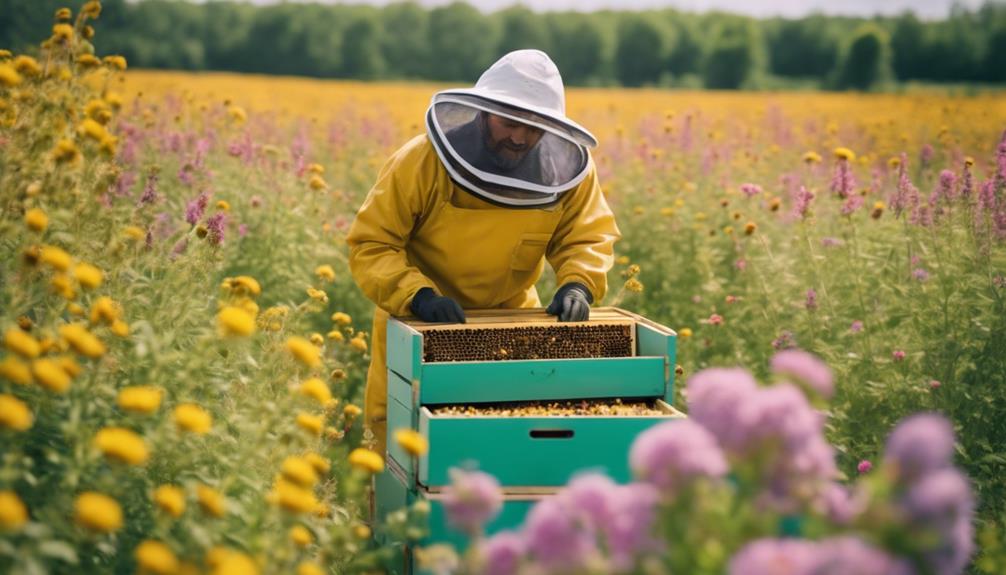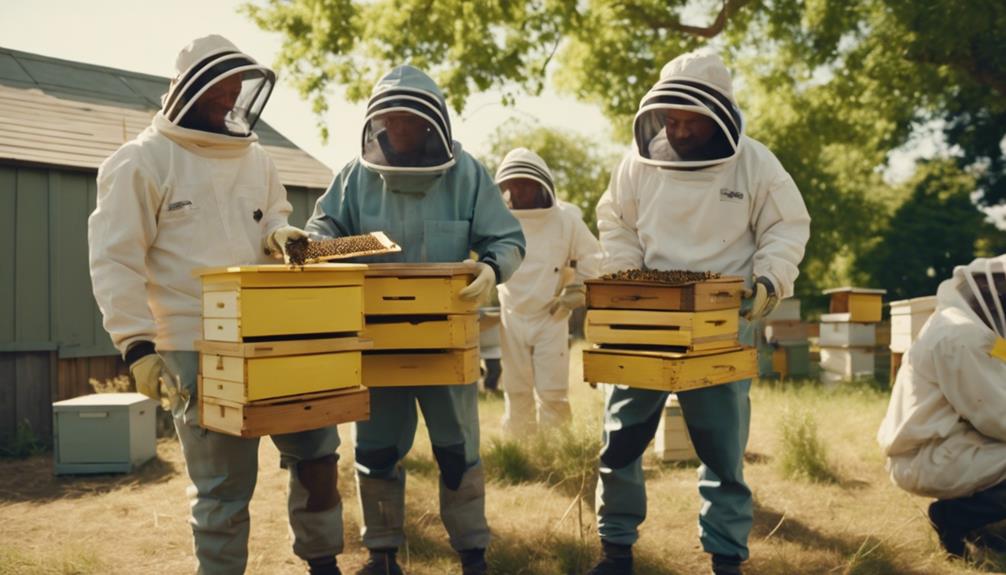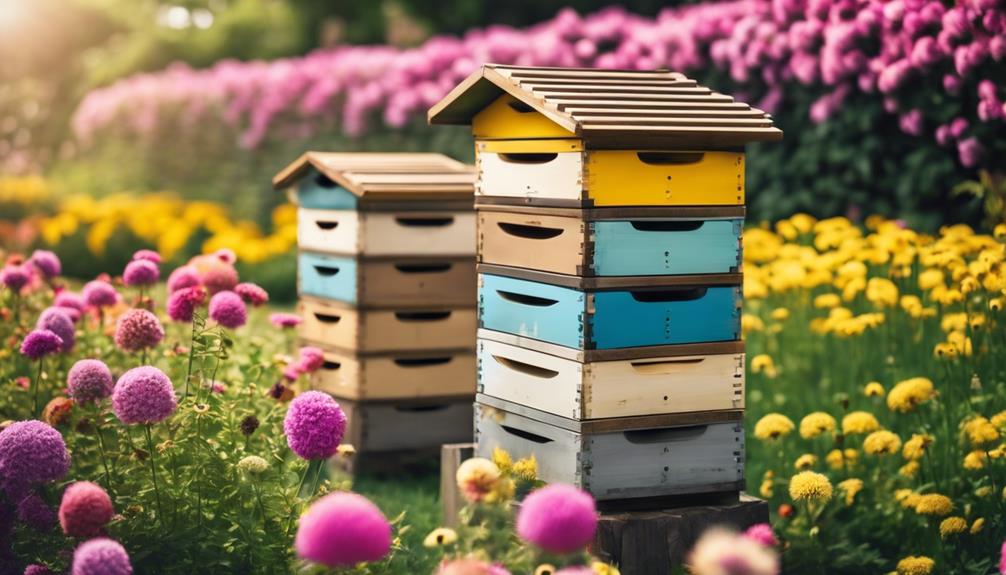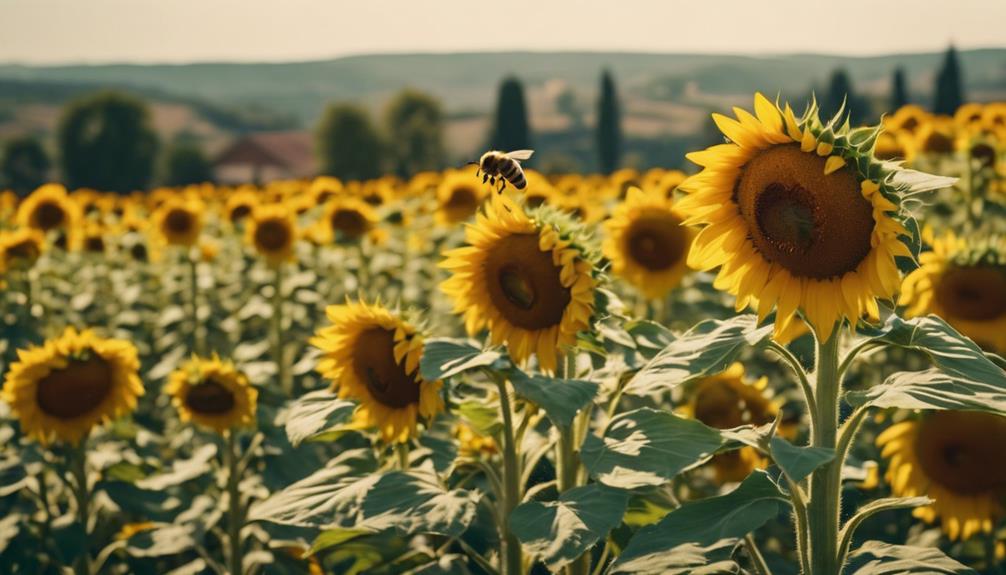Starting beekeeping with two bee boxes can be a smart move for beginners. It’s cost-effective, helps in comparing hive health, and gives flexibility if one hive encounters issues. Plus, having multiple hives boosts your skills, acts as a safety net against failures, and sets a robust foundation for your beekeeping journey. By starting with a couple of hives, you’re not just entering the world of beekeeping; you’re setting yourself up for a solid start in this fascinating hobby.
Main Points
- Consider starting with two bee boxes for cost-effectiveness and learning opportunities.
- Evaluate budget, time commitment, and goals to determine hive numbers.
- Join beekeeping communities for valuable insights on hive management.
- Begin with one hive and gradually expand based on experience and resources.
- Consult experienced beekeepers for guidance on optimal hive numbers.
Factors to Consider Before Starting
Before delving into beekeeping, it’s crucial to assess various factors that can influence the number of bee boxes you should start with. Consider your budget, available space, and the time commitment you can dedicate.
Think about your beekeeping goals and the local nectar sources and climate conditions in your area. These elements play a critical role in determining the best number of bee boxes for your beekeeping venture.
By evaluating these factors thoroughly, you can make an informed decision that aligns with your resources and objectives. Remember, consulting with experienced beekeepers or local associations can offer valuable insights tailored to your specific circumstances.
Taking the time to plan based on these considerations sets an ideal foundation for your beekeeping journey.
Importance of Starting With Multiple Hives
Beginning with multiple hives is essential for beekeepers to hedge against potential setbacks, like hive failures or disease outbreaks. It also allows us to compare hive health and management techniques, helping us refine our beekeeping skills.
With more than one hive, we can engage in practices such as colony equalization and queen introduction, setting a strong foundation for successful beekeeping.
Benefits of Multiple Hives
Starting beekeeping with multiple hives not only improves our chances of success but also offers a valuable opportunity to strengthen our skills and knowledge. By managing more hives, we boost our resilience and create learning opportunities that accelerate our growth as beekeepers.
Sharing resources among colonies, such as eggs, brood, and bees, contributes to better colony health and management. Additionally, comparing the performance of different hives enables us to make informed decisions and adjustments, ensuring ideal bee health and productivity.
Having multiple hives acts as a safety net, providing security in case of colony loss and promoting sustainability for future seasons. It’s truly remarkable how starting with more hives can open up a world of possibilities and benefits for us as beekeepers.
Considerations for Beekeepers
Increasingly, beekeepers are recognizing the importance of starting their beekeeping journey with multiple hives to guarantee resilience and enrich learning opportunities.
Starting with two hives instead of one can make a significant difference in the success of your beekeeping venture. When you have two hives, you can compare their health and behaviors, allowing for better management practices. This comparison also enables you to identify and address issues promptly, preventing the spread of problems to both hives.
If one hive is weaker or faces challenges, having a second hive acts as a safety net, reducing the risk of losing all your bees. Ultimately, managing multiple hives not only increases your chances of success but also provides valuable insights and skills essential for sustainable beekeeping practices.
Benefits of Managing a Few Hives

Managing a few hives offers beekeepers the opportunity to closely observe and care for each colony with focused attention and ease of comparison. Here are some benefits of starting with a small number of hives:
- Easier Comparison: Observing a few hives makes it simpler to notice differences in behavior and health.
- Dedicated Time: With fewer hives, we can spend more quality time tending to each colony’s needs.
- Beginner-Friendly: Starting with a couple of hives reduces overwhelm and allows for a smoother learning curve.
- Individual Focus: Managing a small number of hives enables us to tailor care to each colony’s specific requirements.
Having just a few hives provides a sense of freedom and flexibility in beekeeping, allowing us to truly connect with these fascinating creatures.
Budget-Friendly Hive Number Suggestions
Starting with two bee boxes is a cost-effective way to begin beekeeping. It’s an ideal setup for beginners, allowing us to manage our hives efficiently without breaking the bank.
This approach offers a balanced approach to learning and maintaining bee colonies.
Cost-Effective Hive Options
For those looking to start beekeeping on a budget, beginning with two bee boxes can be a wise and practical choice. Here are some reasons why starting with two bee boxes is a great option for new beekeepers:
- Two bee boxes provide a safety net and flexibility in managing colonies.
- Starting with two bee boxes allows for comparison and learning opportunities.
- Having two bee boxes can prevent a complete loss of bees in case of hive failure.
- Beginners often find starting with two bee boxes more manageable and beneficial for colony health.
Starting with two hives not only offers a safety net but also opens up learning opportunities that can help you become a more successful beekeeper in the long run.
Ideal Beginner Setups
To achieve a cost-effective beekeeping setup as a beginner, consider starting with two bee boxes for improved colony management and resilience. Starting with two bee boxes provides a safety net in case of hive failure, allowing for comparison between hives and aiding in better management decisions. It also reduces the risk of losing all bees in case of colony loss, offering a buffer for your bee colonies.
Opting to start with just one colony may increase the chances of complete bee loss if that hive fails. Having two bee boxes not only enriches your bee yard but also sets the stage for expanding with additional honey supers as your beekeeping skills grow. Starting with two bee boxes is a strategic choice for beginners looking to establish a robust and thriving beekeeping setup.
Time Commitment for Bee Box Management

Ensuring the health and proper management of bee boxes involves checking each hive every two weeks, with an average inspection time of around 10 minutes per hive. Here are some tips to manage your time effectively when tending to your bee boxes:
- Stay Organized: Keep your hive tool and protective clothing ready to streamline your inspection process.
- Connect with Local Beekeepers: Sharing experiences can provide insights to help you manage your hives more efficiently.
- Consider a Second Hive: Once you get the hang of managing one hive, adding a second can increase your beekeeping skills.
- Be Mindful of Resources: Monitoring for signs of a nectar shortage or a full frame of brood can help you anticipate and address potential issues promptly.
Building a Strong Foundation With 2+ Hives
Establishing a strong foundation with 2+ hives improves beekeeping skills and offers a safety net against potential hive failures. Having multiple hives not only guarantees that you have a safety net in case of hive failure but also allows for learning from the differences between the hives.
With two or more hives, you can compare their progress and behavior, leading to better management options and increased resilience in your beekeeping endeavors. This setup reduces the risk of complete loss of bees if one hive encounters issues.
Embracing the challenge of managing multiple hives can be rewarding as it provides a hands-on learning experience that enriches your beekeeping knowledge and skills while safeguarding you against the uncertainties of hive failures.
Tips for Bee Box Distribution

Considering the number of brood boxes needed per hive is important for effective bee box distribution. When deciding how to distribute your bee boxes, keep in mind these helpful tips:
- Start with two brood boxes per hive in colder climates: Ensuring winter survival for your bees is vital, and the extra space provides them with the necessary resources.
- Consider double brood boxes for ample honey: Doubling up can help guarantee that your bees have enough honey stored for the winter months, promoting hive health.
- Join local beekeeping groups for brood box management guidance: Learning from experienced beekeepers can offer valuable insights into optimizing your hive setup for success.
- Proper hive management is key: Regularly monitoring and maintaining your hives can aid in distributing brood boxes effectively and keeping your colonies thriving.
Strategies for Hive Expansion
To improve hive productivity, gradual expansion based on experience and capacity is essential. When starting with a new hive, it’s wise to begin with just one bee box. Learning proper hive management techniques is necessary before considering increasing the number of hives.
By mastering the skills needed to handle more than one hive effectively, you increase your chances of success in beekeeping. Take the time to expand gradually, considering factors like regional beekeeping practices and wildlife impacts. Research and plan accordingly to guarantee a smooth transition as you grow your apiary.
Evaluating your goals and resources will help determine the best number of hives to start with, setting you on the path to successful hive expansion.
Joining Beekeeping Communities for Support

Joining beekeeping communities can provide valuable support and guidance for beginners looking to improve their hive management skills and knowledge. When we connect with experienced beekeepers, we gain insights that help us upgrade our beekeeping practices.
Being part of a beekeeping community offers a network of resources for better hive management, allowing us to learn from others’ experiences and avoid common pitfalls. These communities are fantastic for sharing best practices, troubleshooting issues, and receiving guidance on various beekeeping techniques.

Roger Thomas is a seasoned beekeeper and hive architect with a deep-seated passion for sustainable living. His fascination with bees has shaped his professional career, giving him practical and theoretical expertise in bee behavior, colony health, and optimal hive conditions. Roger’s technical skills shine in his bespoke hive creations that cater to the specific needs of diverse bee species, while his sustainable practices promote environmental balance and the wellbeing of the bee population.
As he continues his journey in beekeeping, Roger has become a dedicated advocate for responsible practices and an insightful educator in his field. His posts aim to inspire new beekeepers, underline the importance of sustainability, and showcase the remarkable contribution bees make to our ecosystem. Roger invites you to join him as he delves into the world of bees and the rewarding, honey-sweet art of beekeeping.


